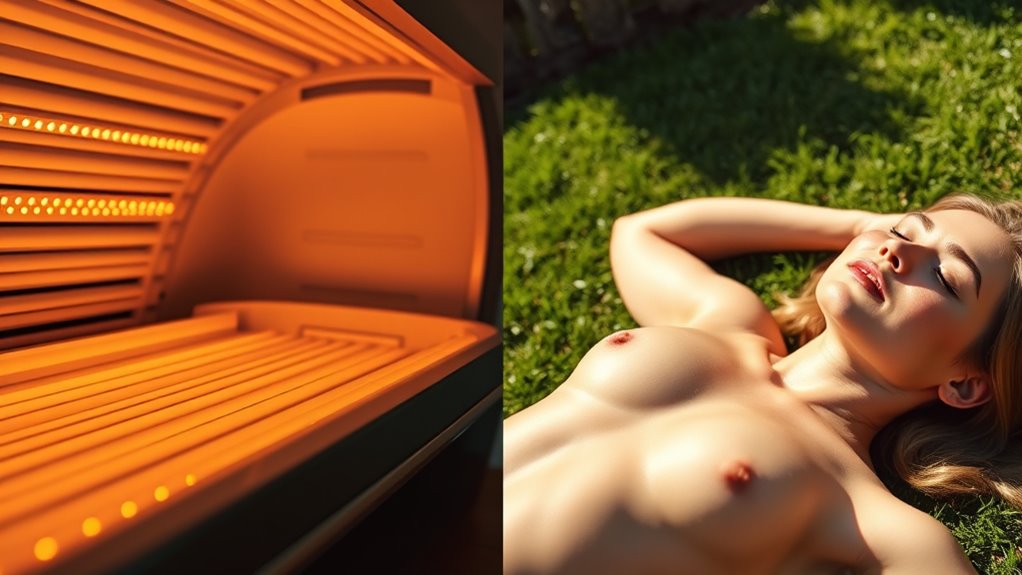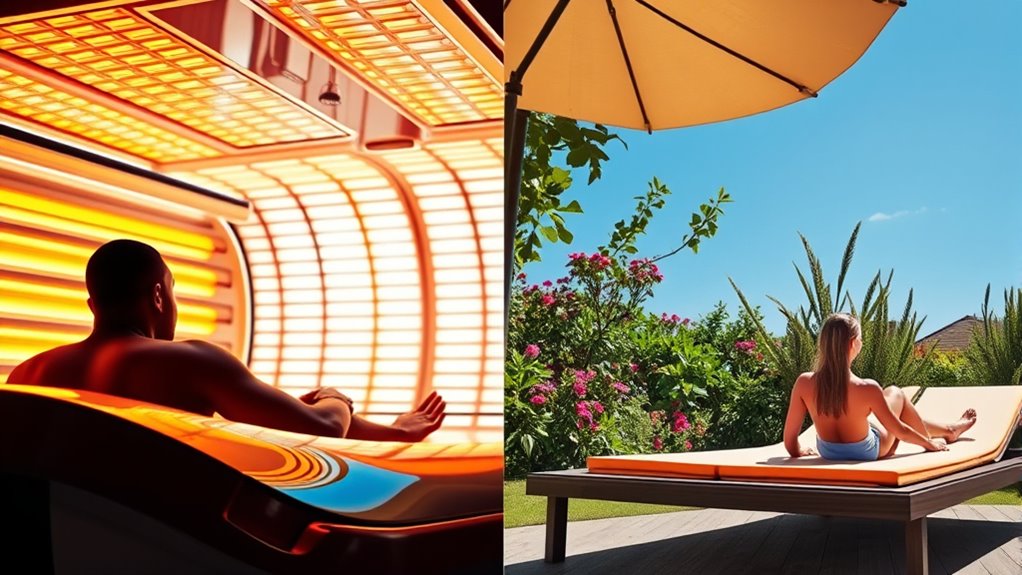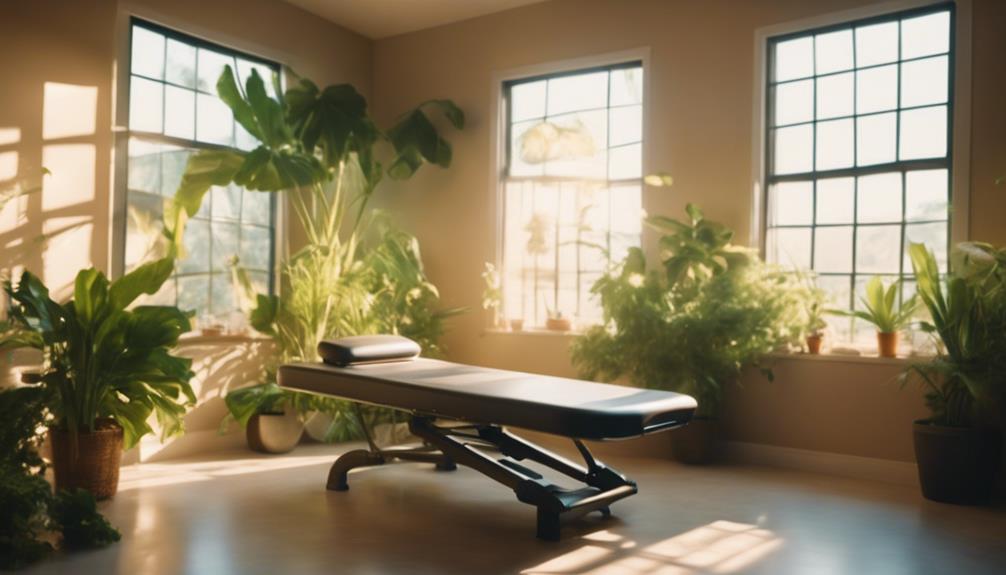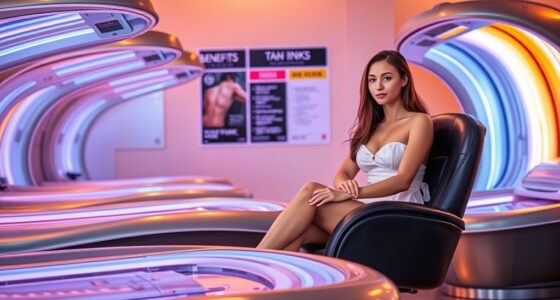Indoor tanning beds deliver concentrated UV rays, often stronger than natural sunlight, which can lead to faster skin damage and higher skin cancer risks. While outdoor tanning involves natural UVB that boosts vitamin D, it also poses skin aging and damage risks if overdone. If you want a safer, balanced approach to tanning, understanding these differences is key, and there’s more to discover about how to protect your skin while getting the look you want.
Key Takeaways
- Indoor tanning delivers concentrated UV rays, often more intense than natural sunlight, increasing skin damage risk.
- Outdoor tanning exposes skin to natural UVB rays that promote vitamin D production, which indoor beds generally lack.
- Indoor tanning primarily emits UVA rays that accelerate skin aging and collagen breakdown, similar to prolonged outdoor exposure.
- Natural sunlight offers health benefits with less risk when exposure is controlled, unlike indoor tanning beds.
- Safer alternatives like sun protection and self-tanning products provide a tan without the harmful effects of UV radiation.

Have you ever wondered whether indoor or outdoor tanning is better for achieving that sun-kissed glow? Both options expose your skin to ultraviolet (UV) radiation, but they do so in very different ways, which impacts not only your appearance but also your health. When deciding between the two, consider how each affects vitamin D synthesis and skin aging. Outdoor tanning naturally exposes you to sunlight, which is the most efficient way to boost vitamin D levels. UVB rays stimulate your skin to produce this essential nutrient, supporting bone health, immune function, and mood. However, prolonged exposure increases your risk of skin damage and accelerates aging, leading to wrinkles, fine lines, and age spots. Indoor tanning beds, on the other hand, emit controlled UV rays, often including both UVA and UVB, to give you a tan without the sun’s direct rays. While this might seem like a safer alternative, it’s not without risks. Tanning beds can deliver high doses of UVA, which penetrates deep into the skin and contributes markedly to premature skin aging. Over time, this can cause collagen breakdown, leading to sagging skin and wrinkles. Even though tanning beds may offer a quicker tan, they don’t provide the same health benefits as natural sunlight, particularly in terms of vitamin D synthesis. Plus, because tanning beds often deliver concentrated doses of UV radiation, they can cause lasting skin damage if used frequently or improperly. It’s tempting to think that indoor tanning is a safer, more controlled way to achieve a tan, but the reality is more complex. Both methods expose your skin to UV radiation, which poses risks for skin aging and skin cancer. If your goal is to maintain youthful skin, prolonged UV exposure—whether indoors or outdoors—should be avoided. The best approach is moderation and sun protection, such as using sunscreen and limiting exposure time. Remember, achieving a glow shouldn’t come at the expense of your health. If you’re looking to maximize vitamin D synthesis, spending short periods in natural sunlight is preferable, as it provides the benefits with less risk of skin damage. Understanding the risks of UV radiation is crucial for making informed decisions about tanning. Ultimately, while indoor tanning might seem convenient, it doesn’t replace the natural benefits—and risks—associated with outdoor sun exposure. Prioritize your skin’s health and aging process by being cautious about UV exposure, and consider safer alternatives like self-tanning products if a tan is your goal.
Frequently Asked Questions
How Does UV Exposure Differ Between Indoor and Outdoor Tanning?
You’ll notice that UV exposure varies between indoor and outdoor tanning. Indoor beds emit a controlled UV spectrum, often with higher UVB levels, which increases tanning efficiency but also risks. Outdoor exposure, on the other hand, involves natural UV rays that fluctuate with the time of day and weather, making the UV spectrum less consistent. This difference impacts how quickly and effectively you tan, with indoor beds typically offering faster results.
Are There Safety Risks Associated With Both Indoor and Outdoor Tanning?
You face serious health risks with both indoor and outdoor tanning—more than just a minor sunburn. The dangers include skin damage and an increased risk of skin cancer. Indoor tanning exposes you to concentrated UV rays, which can accelerate skin aging and cause burns. Outdoor tanning, on the other hand, exposes you to unpredictable UV levels. Either way, both methods pose significant safety risks that you shouldn’t ignore.
Can Indoor Tanning Help Build a Base Tan for Outdoor Sun Exposure?
Indoor tanning can help build a base tan, which may provide some outdoor preparation by slightly increasing your skin’s natural protection. By gradually developing a base tan in a tanning bed, you might reduce the risk of sunburn during outdoor exposure. However, keep in mind that a base tan isn’t foolproof, and you should always practice safe sun habits and avoid overexposure to protect your skin’s health.
How Does Skin Type Influence Tanning Choices Indoors or Outdoors?
Your skin type greatly influences your tanning choices, especially considering skin sensitivity and tanning preferences. If you have sensitive skin, you might prefer indoor tanning to control UV exposure and reduce irritation. For darker skin tones, outdoor tanning may be faster and more effective. Understanding your skin’s response helps you choose the safest option, ensuring you enjoy a tan without risking damage or discomfort.
What Are the Long-Term Skin Health Effects of Indoor Versus Outdoor Tanning?
Did you know that indoor tanning increases your skin cancer risk by 74%? Long-term, both indoor and outdoor tanning can accelerate skin aging and cause pigmentation changes. Indoor tanning often exposes you to concentrated UV rays, intensifying damage. Outdoor tanning involves variable UV exposure, which still harms your skin over time. To protect your skin’s health, minimize UV exposure and consider safer alternatives like self-tanning products.
Conclusion
Whether you prefer indoor or outdoor tanning, both come with risks. Did you know that indoor tanning increases your skin cancer risk by 59%? While outdoor tanning offers natural sun exposure, it also exposes you to harmful UV rays. Ultimately, protecting your skin is key. Consider safer alternatives like self-tanners or spray tans to achieve a glow without the danger. Your skin’s health is worth more than a quick tan—choose wisely!









